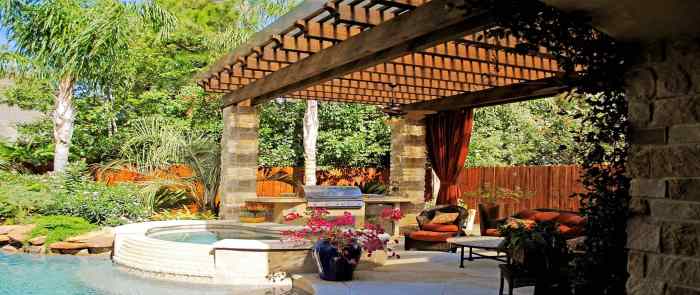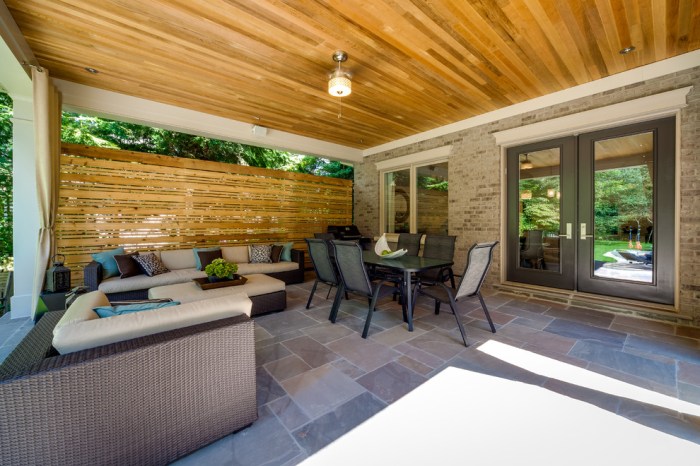Crafting Custom Patio Designs for Homes: A Comprehensive Guide
Embark on a journey through the world of custom patio designs for homes, where creativity meets functionality to transform outdoor spaces into personalized sanctuaries. From selecting materials to integrating landscaping elements, this guide explores all facets of designing a custom patio that suits your unique style and preferences
Delve deeper into the realm of custom patio designs for homes as we unravel the key considerations and innovative ideas that can elevate your outdoor living experience.
Types of Custom Patio Designs

Custom patio designs come in various styles to suit different homes, providing a unique outdoor space for relaxation and entertainment. Each type offers distinct features and benefits, enhancing the overall appeal and functionality of your home.
1. Traditional Patio Design
Traditional patio designs typically feature square or rectangular shapes with simple paving materials like concrete, brick, or stone. These designs often include a seating area, dining space, and maybe a grilling station. The timeless appeal of traditional patio designs makes them a popular choice for many homeowners.
2. Contemporary Patio Design
Contemporary patio designs focus on clean lines, minimalist elements, and modern materials such as metal, glass, and composite decking. These designs often incorporate sleek furniture, fire pits, and water features to create a stylish outdoor living space. Contemporary patio designs are perfect for homes with a modern aesthetic.
3. Mediterranean Patio Design
Mediterranean patio designs draw inspiration from the coastal regions of Southern Europe, featuring warm colors, intricate patterns, and lush greenery. These designs typically include a pergola or arbor, tiled flooring, and Mediterranean-style furniture. Mediterranean patio designs bring a touch of European elegance to your outdoor space.
4. Rustic Patio Design
Rustic patio designs embrace natural materials like wood, stone, and wrought iron to create a cozy and inviting outdoor retreat. These designs often incorporate elements like a fireplace, wooden furniture, and rustic decor to evoke a sense of warmth and charm.
Rustic patio designs are perfect for homes with a country or farmhouse style.
5. Zen Patio Design
Zen patio designs focus on creating a tranquil and harmonious outdoor environment inspired by Japanese gardens. These designs emphasize simplicity, balance, and natural elements like bamboo, gravel, and water features. Zen patio designs often include meditation areas, bonsai trees, and minimalist furniture to promote relaxation and mindfulness.Each type of custom patio design offers unique features and benefits, allowing you to create a personalized outdoor oasis that complements your home's architecture and your lifestyle.
Factors to Consider
When designing a custom patio for your home, there are several key factors to consider to ensure the patio complements your living space seamlessly. Assessing the available space, incorporating the existing architectural style of your home, and other considerations can help you create a functional and aesthetically pleasing outdoor area.
Assessing Available Space
Before designing your custom patio, it is essential to evaluate the available space in your backyard. Consider the size and shape of the area where you plan to build the patio. Take into account any existing landscaping, trees, or structures that may impact the layout of the patio.
By understanding the dimensions and features of the space, you can plan a patio design that maximizes usability and enhances the overall look of your outdoor area.
Incorporating Existing Architectural Style
Another important factor to consider when designing a custom patio is incorporating the existing architectural style of your home. Take cues from the design elements of your house, such as materials, colors, and overall aesthetic, to create a cohesive look between your indoor and outdoor spaces.
Whether your home has a modern, traditional, or contemporary style, integrating these features into your patio design will help create a harmonious flow and enhance the overall curb appeal of your property.
Materials for Custom Patio Designs
When it comes to custom patio designs, choosing the right materials is crucial to achieving the desired look and functionality. Different materials offer varying levels of durability, maintenance requirements, aesthetic appeal, and versatility. Let's explore some of the common materials used in custom patio designs.
1. Concrete
Concrete is a popular choice for patios due to its durability and versatility. It can be stamped, stained, or painted to create various looks. While concrete is relatively low maintenance, it may crack over time and require repairs.
2. Pavers
Pavers are individual units made from various materials such as concrete, brick, or natural stone. They offer a classic and elegant look to patios and are easy to replace if damaged. However, weeds can grow between pavers, requiring regular maintenance.
3. Wood
Wood is a timeless choice for patios, providing a warm and natural aesthetic. Different types of wood, such as cedar or teak, offer varying levels of durability. Wood patios require regular sealing and maintenance to prevent rot and decay.
4. Composite Decking
Composite decking is a blend of wood fibers and recycled plastic, offering the look of wood without the maintenance. It is resistant to rot, fading, and stains, making it a durable option for patios. However, composite decking can be more expensive upfront
.5. Natural Stone
Natural stone, such as flagstone or slate, adds a luxurious and sophisticated touch to patios. It is durable and low maintenance, with a timeless appeal. Natural stone can be more costly than other materials but provides a high-end look.
6. Brick
Brick patios offer a classic and traditional appearance, with various patterns and colors available. Brick is durable and requires minimal maintenance, making it a long-lasting option for custom patio designs.
7. Tile
Tiles come in a wide range of materials, including ceramic, porcelain, and natural stone. They offer endless design possibilities and are easy to clean. However, certain tiles may be prone to cracking or fading over time.
8. Gravel
Gravel is a budget-friendly option for patios, providing a casual and rustic look. It is easy to install and allows for water drainage. However, gravel patios may require regular replenishment and can be less stable than solid surfaces.
Incorporating Landscaping Elements

Incorporating landscaping elements into custom patio designs can greatly enhance the overall look and feel of your outdoor space. By strategically placing plants, trees, flowers, lighting, and outdoor decor, you can create a beautiful and inviting patio area that complements your home's design.
Ideas for Incorporating Plants, Trees, and Flowers
When it comes to incorporating greenery into your patio design, consider planting potted plants along the edges of the patio or creating a vertical garden using climbing plants. Trees can provide shade and a natural, organic element to the space, while flowers can add pops of color and fragrance.
Mixing different types of plants and flowers can create a visually appealing and dynamic patio design.
The Importance of Lighting and Outdoor Decor
Proper lighting is essential for creating ambiance and extending the usability of your patio into the evening hours. Consider installing string lights, lanterns, or even a fire pit to provide warmth and illumination. Outdoor decor such as cushions, rugs, and artwork can add personality and style to your patio, making it a comfortable and inviting space for relaxation or entertaining.
Budgeting and Planning
Planning and budgeting are crucial aspects when it comes to creating a custom patio design that fits both your needs and your wallet. Proper planning ensures that you make the most out of your space, while budgeting helps you stay within financial limits.
Tips for Budgeting
- Set a realistic budget: Determine how much you are willing to spend on your custom patio design project. Consider factors like materials, labor costs, and any additional features you want to include.
- Get multiple quotes: Reach out to several contractors or designers to get a range of estimates. This can help you compare prices and choose the option that best fits your budget.
- Consider long-term costs: While it may be tempting to go for the cheapest option, consider the long-term maintenance costs of different materials and features. Opting for quality now can save you money in the future.
Importance of Proper Planning
Proper planning is essential to creating a functional and aesthetically pleasing patio design. It helps you maximize your outdoor space and ensures that all your needs and preferences are taken into account before construction begins.
Prioritizing Features Based on Budget Constraints
- Identify must-have features: Make a list of features that are non-negotiable for your custom patio design. These could be things like a specific seating area, a fire pit, or a built-in grill.
- Consider alternative materials: If your budget is tight, consider using alternative materials that offer a similar look and feel to more expensive options. For example, stamped concrete can mimic the look of pricier stone pavers.
- Phase out your project: If your budget doesn't allow for all the features you want at once, consider phasing out your project. Start with the essentials and add on additional features as your budget allows over time.
Closing Summary
As we conclude our exploration of custom patio designs for homes, remember that creating a personalized outdoor oasis is not just about aesthetics but also about enhancing your lifestyle. With careful planning and attention to detail, your dream patio can become a reality that brings joy and relaxation for years to come.
FAQ Compilation
What are some unique features in custom patio designs?
Unique features in custom patio designs can include built-in fire pits, water features, outdoor kitchens, and pergolas, adding both style and functionality to the space.
How can I assess the available space for patio design?
To assess the available space for patio design, measure the dimensions of the area and consider factors like existing structures, sunlight exposure, and proximity to the house for easy access.
What are some common materials used in custom patio designs?
Common materials used in custom patio designs include concrete, stone pavers, brick, wood, and composite decking, each offering unique benefits in terms of durability and aesthetics.
Why is proper planning important in creating functional patio designs?
Proper planning is crucial in creating functional patio designs as it helps optimize space utilization, ensure seamless integration with the home's architecture, and prioritize features based on budget constraints.




